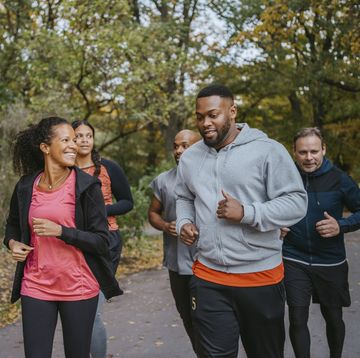- According to a recent study in the journal Medicine & Science in Sports & Exercise, people who receive positive information right before exercise tend to have a higher pain threshold compared to those getting negative info.
- Your mind-body connection is strong, and if you expect the pain level to be higher—and that you’ll suffer more as a result—simply believing that can go a long way toward causing it to be true.
- This concept applies to every form of exercise: your strength training sessions, long runs, and track workouts.
Experiencing muscle pain during any kind of workout is certainly nothing new, but what you’re hearing before the workout could actually change how much pain you can withstand.
A recent study in the journal Medicine & Science in Sports & Exercise found that people who receive positive information right before exercise tend to have a higher pain threshold compared to those who heard negative info.
Researchers recruited 83 people, and separated them into three groups—one group of people received positive information before a workout, one group received neutral information, and one group received negative information. The positive group was told that exercise can reduce the experience of pain, the neutral group was given just basic instructions, and the negative group was informed that exercise is likely to induce both pain before and afterwards.
Researchers assessed their pain levels in the thigh and trapezius muscle (located in the upper back, which helps move your neck, shoulders, and arms) before and after squatting, as well as each person’s expectations of pain. All participants were given verbal and visual instructions on squat exercises, then did 30 minutes of exercise.
Those in the positive information group had a 22-percent increase in their quadriceps pain threshold, while those in the negative information group showed a four-percent decrease. That means the participants in the “negative” group felt more pain during the same type of exercise, based solely on the info they got right before the workout.
But it isn’t just the information itself at play here. What’s important to understand is how people perceived the pain they were about to experience, lead study author Henrik Bjarke Vaegter, Ph.D., associate professor of physiotherapy and head of the Pain Research Group at the University of Southern Denmark’s Pain Center, told Runner’s World.
“Our results suggest that, in general, we have positive expectations that exercise changes the way we experience pain,” he said. “We also observe this positive effect with higher pain thresholds and higher pain tolerance after exercise. However, if we receive negative information, the positive effect on pain seems to disappear.”
That info can come from anywhere, he added, such as health professionals, the media, even fellow exercisers. Basically, if you expect the pain level to be higher—and that you’ll suffer more as a result—simply believing that can go a long way toward causing it to be true. This goes for not only your strength training sessions—this concept can be applied to mile 18 of your long run and your last 800 on the track, too.
[The Beginner’s Guide to Strength Training will teach you all the fundamentals to get the most out of your weight session.]
In terms of why this might be the case, Vaegter said there is an extensive amount of research demonstrating that the experience of pain can be influenced by our thoughts, beliefs, and expectations.
The mechanism, he added, is likely related to the way these thoughts affect the endogenous cannabinoid system—the bridge between the body and mind—which is involved in the process of modulating our pain response. Your thoughts can hack that system and lower your pain level as a result.
Vaegter said previous studies have shown this can be the case when taking pain medication, for instance. Patients often find relief well before the meds can take effect, because they are anticipating that lower amount of pain, which actually causes it to happen.
“What we say, think, and expect can have a profound effect,” says Vaegter. “The less you expect pain, the less you get. So, doing exercises that you think will lead to negative experiences is likely not the best way to go.”
Elizabeth Millard is a freelance writer focusing on health, wellness, fitness, and food.













